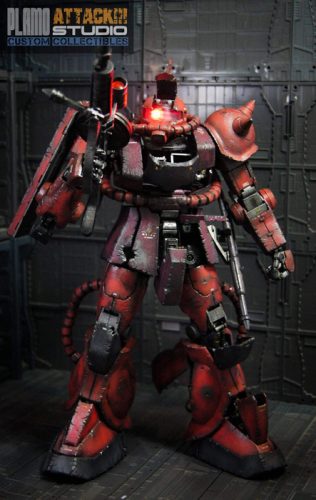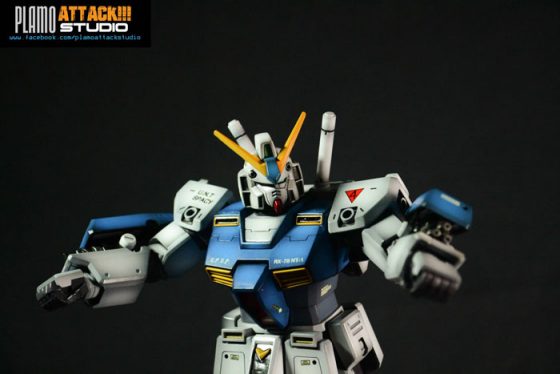It’s inevitable that after watching enough Gundam you’ll be so touched by its stories of how horrible war is that you’ll want to get your hands on the totally awesome war machines it promotes. Sadly, science is more interested in curing cancers and reminding people not to infect themselves with measles than letting you pilot your own death machine, so you’ll have to make due with gunpla. An amalgam of the words “Gundam” and “plastic model,” these small replicas of the famous mech franchise’s giant robots are the fandom’s most prominent staple. Like a Lego kit, each gunpla is packaged in individual pieces with the assembly accounting for most of the fun. Unlike Lego, though, gunpla feature a level of detail, accessories, and poseability that nearly match their inspirations, and we're here to show you how to get started.
Explaining Gundam Grades and Scales

Gunpla offers a lot of different size options, indicated on their boxes by fractions that represent the scale of the model to the size of the robots in the show. Most gunpla come in 1/144, 1/100 and 1/60 scale, usually (but not always) getting more detailed as they scale up. There are also the rare 1/48 scale models which are the largest and scarcest and the SD scale models, which are chibified versions of other models more focused on looking cute than being accurate. They have the cheapest plastic, fewest parts and lowest costs, so they’re pretty good for beginners, but they hold little value past that except for those who find their aesthetic appealing.
Grades, on the other hand, show how detailed your gunpla will be and tend to be shortened to an acronym. The somewhat deceptively titled high grade (HG) models are the least detailed and most affordable aside from the SD ones, followed by the master grade (MG) which require more skill but sit at a middle ground that combines intricacy with attainable prices and the perfect grade (PG) require an obscene amount of skill and money to pull off, but are without a doubt the most stunning gunpla the industry has to offer. Somewhat less talked about are the real grades (RG), which are roughly as easy to put together as HG but with nuances and details more on par with MG and the Reborn-One Hundred (RE) grade, which is like HG but with larger parts that culminate in the scale mentioned in the name once completed.
Unboxing

Once you’ve grabbed the model kit you want in the scale and grade you feel is most appropriate for you, it’s time to take your pieces out. They won’t be loose in the box, though; all the pieces are attached to sprues. The good news is that you can easily detach the pieces simply by twisting them off with your hands, but this can leave small chunks of the sprue stuck to the piece, so we recommend using side-cutters if that’s an option available to you.

Those will still leave you with little plastic nubs stuck to your pieces on occasion, though, but that can easily be dealt with by shaving off the imperfection with a common hobby knife, X-Acto knife, or anything else that can give you a really precise cut. Once you’re satisfied with how a piece looks, all you need to do is attach it to the other ones by following the instructions.
Oh, and we should probably warn you that those instructions will be entirely in Japanese. But fear not, building your model kit by following the pictures alone is not only doable but easy. There's actually very little text to read even if you wanted to and half of it is just the Latin letters and Arabic numerals used to identify the pieces in the kit and the sprue they can be found on. For example, if the instructions tell you to start by connecting piece A2 to B1, you'll just need to grab the second piece from sprue A and the first piece from sprue B and connect them in the manner shown in the diagram. The best part is that there's no need for extra tools or anything at this point, the pieces will all attach on their own with no need for glue or any other additional work, so just make sure you follow the instructions and you'll have a finished gunpla in no time.
Posing

After you’ve finished assembling your model kit, the first thing you're likely to notice is that playing around with all the different poses and accessories now available to you is awesome. Your kit may also come with its own action base stand (and if it doesn't, you can buy them for cheap), which will let you pose your gunpla however you like without needing to worry about it supporting itself. You can re-enact all your favorite moments from the show and create new favorites on your own. The most important rule with your completed gunpla, though, is to have fun.

Final Thoughts
Naturally, there's a lot more that you can do with gunpla. There's primer, masking, topcoat, weathering and a ton of other cool stuff, but the basics covered here are all you'll need to get yourself started. Be sure to let us know your experiences with gunpla in the comments and be sure to stick around for more.

